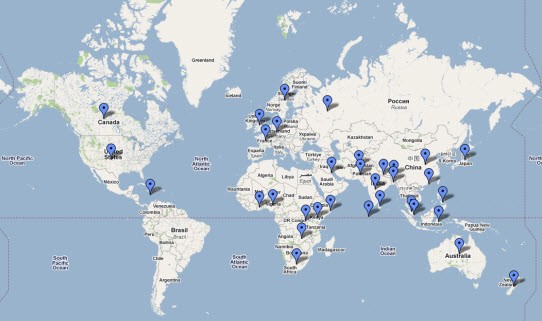Ellen Sandell, from the Australian Youth Climate Coalition, writes: I was going to write an article today about why Greg Hunt and Tony Abbott should stop playing politics with climate change, and come to the table. But instead of spending 800 words berating them for refusing to join the multi-party climate change committee, I’m going to talk about hope. This is an article about good news stories, and how Australia can be one of them.
Tim Flannery has just released a new book called Here On Earth, and far from being a lament about the state of the world, he describes it as prosecuting the case for hope.
This might come as a bit of a surprise, given that he has spent a large part of his career working to solve the global challenge of climate change. Given the enormity of the task, and the vested interests working against him, I suspect few people would blame Tim if he decided to throw his hands up in despair.
Instead, he’s decided to prosecute the case for love and hope. And he’s right. At this moment, we have more to be hopeful about than in the previous few years.
For example, three years ago the Scottish Government announced a target to source 50% of their electricity from renewable energy by 2020 — and it was dismissed as unachievable and unworkable. Yet, just days ago they decided to up their ambition to 80%, because they met their original target ahead of schedule. And what’s more, their government has acknowledged that reaching this target will mean massive environmental, economic and social gains for their country.
Scotland is not the only one catching on to these opportunities. Take a look around the world and you’ll find that 32 countries now have emissions trading schemes — including the UK and the EU. Even China, often seen as the key to a global deal, has committed to putting a price on carbon next year. India also recently announced its plan to start an emissions trading scheme very soon.
We often don’t tell these good news stories. We ought to. The greatest fear coming out of the Copenhagen climate conference was that the world would see it as a failure, and give up on ever being able to solve such a large, global problem. Talking to taxi drivers, and family and friends around the dinner table, this seems to still be the pervading view. But it is fundamentally incorrect, and it’s time we started to tell people what’s really going on.
The truth is that the rest of the world is doing something, but Australia and the USA, the two largest polluters per capita, are trailing behind.
The world is moving, and even the staunchest climate skeptics, such as Danish academic Bjorn Lomborg and Michael Hanlon of Britain’s Daily Mail, have started coming out of the closet, admitting they’ve taken another look at the science and discovered we do indeed have a climate problem.
Tiny Pacific nations who have the most to lose from the impacts of climate change, are taking bold actions. This month, Kiribati, committed to close over 38 million hectares of its territory to fishing, even though this activity accounts for nearly half the government’s tax revenue. Its reason? “That we need to make sacrifices to provide a future for our children and grandchildren” said President Anote Tong.
This is a country that has everything to lose from climate change. If they can put so much on the line to do their bit to solve a problem they did almost nothing to create, it’s hard to say that we can’t do more.
Hopefully though, recent movements at home have shown that Australia can be part of the good news stories.
Numerous big businesses, including BHP, have come out in support of a price on carbon. Regardless of their motive, it’s re-starting the discussion and putting climate change back into our living rooms. Climate change is again getting a hearing in our Parliament, despite the Coalition’s efforts to thwart plans to introduce a much-needed carbon price.
Let’s also not forget that government action is backed up by an enormous grassroots movement of citizens worldwide. The Australian Youth Climate Coalition is part of the International Youth Climate Movement. We have lost count of how many groups and coalitions are part of this movement, but this map gives you an idea of the groups we know about.
In his much-quoted graduation speech in 2009, environmentalist and author Paul Hawken famously said: “If you look at the science about what is happening on earth and aren’t pessimistic, you don’t understand the data. But if you meet the people who are working to restore this earth, and you aren’t optimistic, you haven’t got a pulse”.
At this point in time, we have a lot to be optimistic about, but only if laggards like Australia and the US start coming to the party. That means putting political posturing aside and really working for the good of the country and the globe (I’m talking to you Greg Hunt and Tony Abbott). Australia is one of the sunniest and windiest countries on earth. If Scotland and Kiribati can do it, so can we.
Ellen Sandell in General Manager of the Australian Youth Climate Coalition and 2009 Joint Young Environmentalist of the Year.








Crikey is committed to hosting lively discussions. Help us keep the conversation useful, interesting and welcoming. We aim to publish comments quickly in the interest of promoting robust conversation, but we’re a small team and we deploy filters to protect against legal risk. Occasionally your comment may be held up while we review, but we’re working as fast as we can to keep the conversation rolling.
The Crikey comment section is members-only content. Please subscribe to leave a comment.
The Crikey comment section is members-only content. Please login to leave a comment.